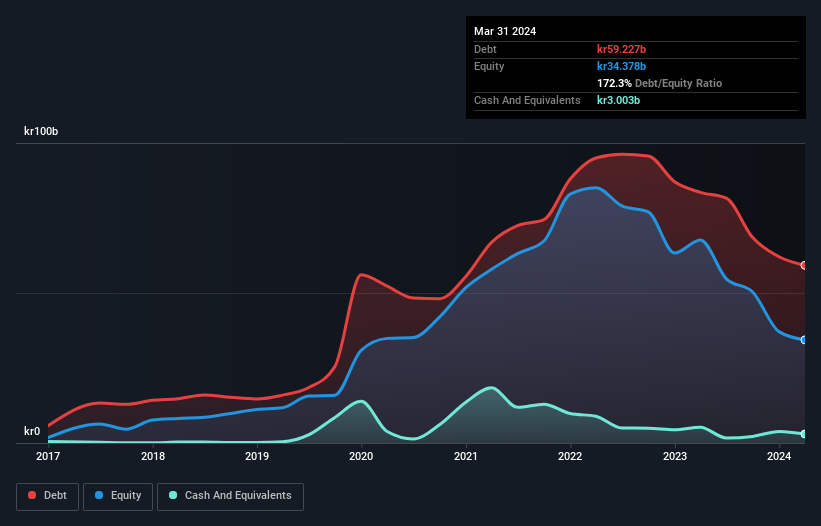- Sweden
- /
- Real Estate
- /
- OM:SBB B
Does Samhällsbyggnadsbolaget i Norden (STO:SBB B) Have A Healthy Balance Sheet?

Legendary fund manager Li Lu (who Charlie Munger backed) once said, 'The biggest investment risk is not the volatility of prices, but whether you will suffer a permanent loss of capital.' When we think about how risky a company is, we always like to look at its use of debt, since debt overload can lead to ruin. As with many other companies Samhällsbyggnadsbolaget i Norden AB (publ) (STO:SBB B) makes use of debt. But is this debt a concern to shareholders?
Why Does Debt Bring Risk?
Debt and other liabilities become risky for a business when it cannot easily fulfill those obligations, either with free cash flow or by raising capital at an attractive price. Ultimately, if the company can't fulfill its legal obligations to repay debt, shareholders could walk away with nothing. However, a more usual (but still expensive) situation is where a company must dilute shareholders at a cheap share price simply to get debt under control. Of course, plenty of companies use debt to fund growth, without any negative consequences. When we think about a company's use of debt, we first look at cash and debt together.
View our latest analysis for Samhällsbyggnadsbolaget i Norden
What Is Samhällsbyggnadsbolaget i Norden's Net Debt?
As you can see below, Samhällsbyggnadsbolaget i Norden had kr59.2b of debt at March 2024, down from kr83.6b a year prior. However, because it has a cash reserve of kr3.00b, its net debt is less, at about kr56.2b.

How Healthy Is Samhällsbyggnadsbolaget i Norden's Balance Sheet?
Zooming in on the latest balance sheet data, we can see that Samhällsbyggnadsbolaget i Norden had liabilities of kr18.7b due within 12 months and liabilities of kr49.4b due beyond that. Offsetting these obligations, it had cash of kr3.00b as well as receivables valued at kr830.0m due within 12 months. So its liabilities total kr64.2b more than the combination of its cash and short-term receivables.
This deficit casts a shadow over the kr11.1b company, like a colossus towering over mere mortals. So we definitely think shareholders need to watch this one closely. After all, Samhällsbyggnadsbolaget i Norden would likely require a major re-capitalisation if it had to pay its creditors today.
In order to size up a company's debt relative to its earnings, we calculate its net debt divided by its earnings before interest, tax, depreciation, and amortization (EBITDA) and its earnings before interest and tax (EBIT) divided by its interest expense (its interest cover). This way, we consider both the absolute quantum of the debt, as well as the interest rates paid on it.
Samhällsbyggnadsbolaget i Norden has a rather high debt to EBITDA ratio of 22.0 which suggests a meaningful debt load. But the good news is that it boasts fairly comforting interest cover of 2.8 times, suggesting it can responsibly service its obligations. Another concern for investors might be that Samhällsbyggnadsbolaget i Norden's EBIT fell 14% in the last year. If things keep going like that, handling the debt will about as easy as bundling an angry house cat into its travel box. There's no doubt that we learn most about debt from the balance sheet. But ultimately the future profitability of the business will decide if Samhällsbyggnadsbolaget i Norden can strengthen its balance sheet over time. So if you want to see what the professionals think, you might find this free report on analyst profit forecasts to be interesting.
Finally, while the tax-man may adore accounting profits, lenders only accept cold hard cash. So it's worth checking how much of that EBIT is backed by free cash flow. Over the most recent three years, Samhällsbyggnadsbolaget i Norden recorded free cash flow worth 54% of its EBIT, which is around normal, given free cash flow excludes interest and tax. This free cash flow puts the company in a good position to pay down debt, when appropriate.
Our View
On the face of it, Samhällsbyggnadsbolaget i Norden's net debt to EBITDA left us tentative about the stock, and its level of total liabilities was no more enticing than the one empty restaurant on the busiest night of the year. But on the bright side, its conversion of EBIT to free cash flow is a good sign, and makes us more optimistic. Taking into account all the aforementioned factors, it looks like Samhällsbyggnadsbolaget i Norden has too much debt. While some investors love that sort of risky play, it's certainly not our cup of tea. There's no doubt that we learn most about debt from the balance sheet. However, not all investment risk resides within the balance sheet - far from it. For example Samhällsbyggnadsbolaget i Norden has 3 warning signs (and 2 which are significant) we think you should know about.
If, after all that, you're more interested in a fast growing company with a rock-solid balance sheet, then check out our list of net cash growth stocks without delay.
New: Manage All Your Stock Portfolios in One Place
We've created the ultimate portfolio companion for stock investors, and it's free.
• Connect an unlimited number of Portfolios and see your total in one currency
• Be alerted to new Warning Signs or Risks via email or mobile
• Track the Fair Value of your stocks
Have feedback on this article? Concerned about the content? Get in touch with us directly. Alternatively, email editorial-team (at) simplywallst.com.
This article by Simply Wall St is general in nature. We provide commentary based on historical data and analyst forecasts only using an unbiased methodology and our articles are not intended to be financial advice. It does not constitute a recommendation to buy or sell any stock, and does not take account of your objectives, or your financial situation. We aim to bring you long-term focused analysis driven by fundamental data. Note that our analysis may not factor in the latest price-sensitive company announcements or qualitative material. Simply Wall St has no position in any stocks mentioned.
About OM:SBB B
Samhällsbyggnadsbolaget i Norden
Owns, develops, and manages residential and social infrastructure properties in Sweden, Norway, Finland, and Denmark.
Fair value with moderate growth potential.
Similar Companies
Market Insights
Community Narratives



